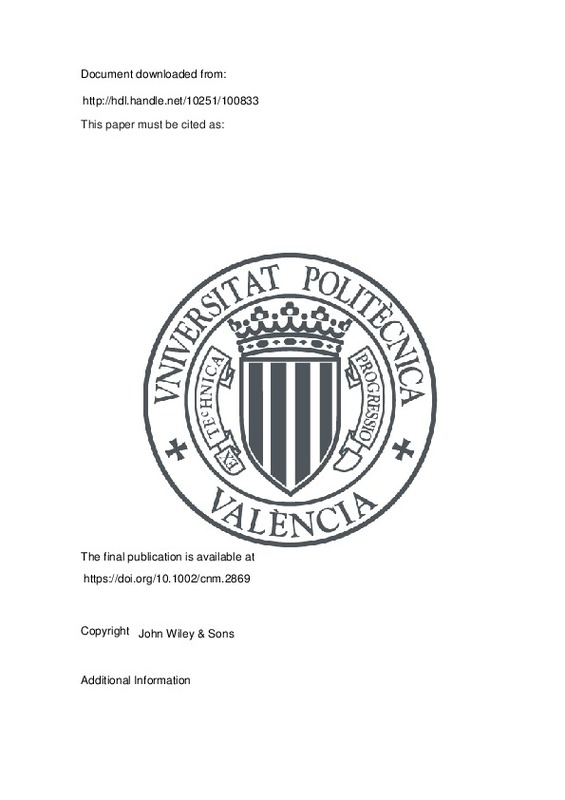Berjano, E. J. (2006). BioMedical Engineering OnLine, 5(1), 24. doi:10.1186/1475-925x-5-24
Pearce, J. A. (2013). Comparative analysis of mathematical models of cell death and thermal damage processes. International Journal of Hyperthermia, 29(4), 262-280. doi:10.3109/02656736.2013.786140
Wittkampf, F. H. M., Nakagawa, H., Yamanashi, W. S., Imai, S., & Jackman, W. M. (1996). Thermal Latency in Radiofrequency Ablation. Circulation, 93(6), 1083-1086. doi:10.1161/01.cir.93.6.1083
[+]
Berjano, E. J. (2006). BioMedical Engineering OnLine, 5(1), 24. doi:10.1186/1475-925x-5-24
Pearce, J. A. (2013). Comparative analysis of mathematical models of cell death and thermal damage processes. International Journal of Hyperthermia, 29(4), 262-280. doi:10.3109/02656736.2013.786140
Wittkampf, F. H. M., Nakagawa, H., Yamanashi, W. S., Imai, S., & Jackman, W. M. (1996). Thermal Latency in Radiofrequency Ablation. Circulation, 93(6), 1083-1086. doi:10.1161/01.cir.93.6.1083
Pinto, C. H., Taminiau, A. H. M., Vanderschueren, G. M., Hogendoorn, P. C. W., Bloem, J. L., & Obermann, W. R. (2002). Technical Considerations in CT-Guided Radiofrequency Thermal Ablation of Osteoid Osteoma: Tricks of the Trade. American Journal of Roentgenology, 179(6), 1633-1642. doi:10.2214/ajr.179.6.1791633
Fukushima, T., Ikeda, K., Kawamura, Y., Sorin, Y., Hosaka, T., Kobayashi, M., … Kumada, H. (2015). Randomized Controlled Trial Comparing the Efficacy of Impedance Control and Temperature Control of Radiofrequency Interstitial Thermal Ablation for Treating Small Hepatocellular Carcinoma. Oncology, 89(1), 47-52. doi:10.1159/000375166
Abraham, J. P., & Sparrow, E. M. (2007). A thermal-ablation bioheat model including liquid-to-vapor phase change, pressure- and necrosis-dependent perfusion, and moisture-dependent properties. International Journal of Heat and Mass Transfer, 50(13-14), 2537-2544. doi:10.1016/j.ijheatmasstransfer.2006.11.045
Pätz, T., Kröger, T., & Preusser, T. (2009). Simulation of Radiofrequency Ablation Including Water Evaporation. World Congress on Medical Physics and Biomedical Engineering, September 7 - 12, 2009, Munich, Germany, 1287-1290. doi:10.1007/978-3-642-03882-2_341
Hall, S. K., Ooi, E. H., & Payne, S. J. (2015). Cell death, perfusion and electrical parameters are critical in models of hepatic radiofrequency ablation. International Journal of Hyperthermia, 31(5), 538-550. doi:10.3109/02656736.2015.1032370
Chang, I. A. (2010). Considerations for Thermal Injury Analysis for RF Ablation Devices~!2009-09-09~!2009-12-19~!2010-02-04~! The Open Biomedical Engineering Journal, 4(2), 3-12. doi:10.2174/1874120701004020003
Beop-Min Kim, Jacques, S. L., Rastegar, S., Thomsen, S., & Motamedi, M. (1996). Nonlinear finite-element analysis of the role of dynamic changes in blood perfusion and optical properties in laser coagulation of tissue. IEEE Journal of Selected Topics in Quantum Electronics, 2(4), 922-933. doi:10.1109/2944.577317
Chang, I. A., & Nguyen, U. D. (2004). BioMedical Engineering OnLine, 3(1), 27. doi:10.1186/1475-925x-3-27
Schutt, D. J., & Haemmerich, D. (2008). Effects of variation in perfusion rates and of perfusion models in computational models of radio frequency tumor ablation. Medical Physics, 35(8), 3462-3470. doi:10.1118/1.2948388
Doss, J. D. (1982). Calculation of electric fields in conductive media. Medical Physics, 9(4), 566-573. doi:10.1118/1.595107
Hasgall PA Di Gennaro F Baumgartner C IT'IS Database for thermal and electromagnetic parameters of biological tissues 10.13099/VIP21000-03-0 www.itis.ethz.ch/database
Pandharipande, P. V., Krinsky, G. A., Rusinek, H., & Lee, V. S. (2005). Perfusion Imaging of the Liver: Current Challenges and Future Goals. Radiology, 234(3), 661-673. doi:10.1148/radiol.2343031362
Tsushima, Y., Funabasama, S., Aoki, J., Sanada, S., & Endo, K. (2004). Quantitative perfusion map of malignant liver tumors, created from dynamic computed tomography data1. Academic Radiology, 11(2), 215-223. doi:10.1016/s1076-6332(03)00578-6
Irastorza, R. M., Trujillo, M., Martel Villagrán, J., & Berjano, E. (2016). Computer modelling of RF ablation in cortical osteoid osteoma: Assessment of the insulating effect of the reactive zone. International Journal of Hyperthermia, 32(3), 221-230. doi:10.3109/02656736.2015.1135998
Goldberg, S. N., Stein, M. C., Gazelle, G. S., Sheiman, R. G., Kruskal, J. B., & Clouse, M. E. (1999). Percutaneous Radiofrequency Tissue Ablation: Optimization of Pulsed-Radiofrequency Technique to Increase Coagulation Necrosis. Journal of Vascular and Interventional Radiology, 10(7), 907-916. doi:10.1016/s1051-0443(99)70136-3
Trujillo, M., Bon, J., José Rivera, M., Burdío, F., & Berjano, E. (2016). Computer modelling of an impedance-controlled pulsing protocol for RF tumour ablation with a cooled electrode. International Journal of Hyperthermia, 32(8), 931-939. doi:10.1080/02656736.2016.1190868
Venkatesan, A. M., Kadoury, S., Abi-Jaoudeh, N., Levy, E. B., Maass-Moreno, R., Krücker, J., … Wood, B. J. (2011). Real-time FDG PET Guidance during Biopsies and Radiofrequency Ablation Using Multimodality Fusion with Electromagnetic Navigation. Radiology, 260(3), 848-856. doi:10.1148/radiol.11101985
Ertürk, M. A., Sathyanarayana Hegde, S., & Bottomley, P. A. (2016). Radiofrequency Ablation, MR Thermometry, and High-Spatial-Resolution MR Parametric Imaging with a Single, Minimally Invasive Device. Radiology, 281(3), 927-932. doi:10.1148/radiol.2016151447
Bishop, M., Rajani, R., Plank, G., Gaddum, N., Carr-White, G., Wright, M., … Niederer, S. (2015). Three-dimensional atrial wall thickness maps to inform catheter ablation procedures for atrial fibrillation. Europace, 18(3), 376-383. doi:10.1093/europace/euv073
Wang, H., Kang, W., Carrigan, T., Bishop, A., Rosenthal, N., Arruda, M., & Rollins, A. M. (2011). In vivo intracardiac optical coherence tomography imaging through percutaneous access: toward image-guided radio-frequency ablation. Journal of Biomedical Optics, 16(11), 110505. doi:10.1117/1.3656966
[-]







![[Cerrado]](/themes/UPV/images/candado.png)


